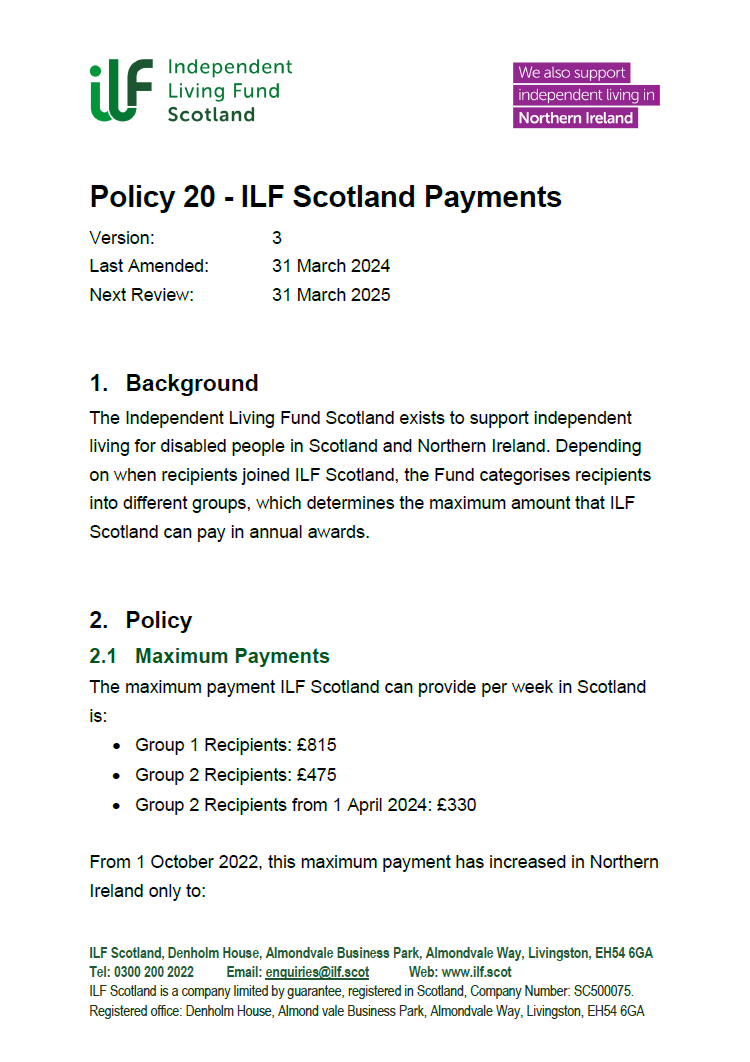
Version: 3
Last Amended: 31 March 2024
Next Review: 31 March 2025
The Independent Living Fund Scotland exists to support independent living for disabled people in Scotland and Northern Ireland. Depending on when recipients joined ILF Scotland, the Fund categorises recipients into different groups, which determines the maximum amount that ILF Scotland can pay in annual awards.
The maximum payment ILF Scotland can provide per week in Scotland is:
From 1 October 2022, this maximum payment has increased in Northern Ireland only to:
With effect from 1 October 2018 in Scotland and from 1 October 2022 in Northern Ireland, ILF Scotland can make a payment that results in exceeding the maximum award in the following circumstances:
Any excess will apply only to the gross ILF element of a total care / support package.
ILF Scotland can make a payment above the maximum weekly award in respect of any week throughout the year, but it must ensure that the total awards in any one year does not exceed the total, relevant, maximum sum. For averaged payments, ILF Scotland calculates the maximum sum by multiplying the maximum weekly award by the number of weeks the recipient is eligible to receive ILF Scotland funding.
Some recipients have a replacement award at certain times during the year, usually to provide short term care e.g. respite. Recipients can choose to receive a specific payment for the relevant periods, or they can choose to receive an averaged payment see Policy 36 - Short-Term Care. ILF Scotland calculates this by dividing the annual cost of support by the number of weeks a recipient is eligible and pay this as an average weekly amount.
For the purposes of our calculations, the year runs from 1 April to 31 March and consists of 52 weeks. A recipient cannot request that we take into account unspent monies from a previous financial year.
ILF Scotland can consider making one-off payments to meet non-recurring costs e.g. PVG checks or health and safety training costs provided this is in line with the Employer Support Information Note.
If a recipient is admitted to temporary residential care / respite at a registered care home / hospital, ILF Scotland can continue to make payments for up to 28 days. In these circumstances, ILF Scotland recipients should minimise expense and rearrange or cancel support where possible.
ILF Scotland can pay for temporary stays for a maximum of 28 days for each stay and for a maximum of 26 weeks in any 52-week period. Recipients are required to provide ILF Scotland with dates of temporary admissions to residential care, respite and hospital.
ILF Scotland will establish whether the Health & Social Care Partnership / Trust will continue to meet the relevant Threshold Sum during periods of temporary stays in alternative accommodation although it can decide to make a payment whether or not this is the case.
A recipient can use ILF Scotland funding to:
ILF Scotland can continue to pay awards in relation to stays in care homes, hospitals, etc. in excess of 28 days in accordance with Policy 38 - Suspension and Reinstatement of an ILF Scotland Award.
ILF Scotland recipients may set aside funding during the year to use at different times to meet their independent living outcomes. This might be to meet employer’s costs e.g. National Insurance contributions or holiday pay. Alternatively, a recipient might save to pay for PA/Provider support for a holiday later in the year.
At any time, recipients may hold a contingency of one week’s funding for unexpected expenditure. This sum is net of any outstanding PA wages or Provider invoices due to be paid.
Where a recipient has accumulated unspent money in excess of the allowable amounts outlined above, recipients should return this unspent money to ILF Scotland.
Where a recipient has accrued unspent money because of ongoing changes to care/support needs, ILF Scotland may consider that a review and reassessment of support requirements is necessary.
If a recipient’s circumstances change and they cease to be eligible for funding part way through a year but have continued to receive ILF Scotland funding, this may result in an overpayment of funds, which will have to be returned to ILF Scotland.
1 July 2015
24 May 2021
31 March 2024
Policy 4 - Recipient Contribution
Policy 36 - Short Term Care
Policy 38 - Suspension and Reinstatement of an ILF Scotland Award
Policy 41 - Use of ILF Scotland Funding
Employer Support Information Note - 31 March 2021